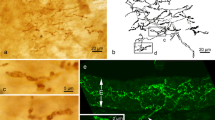Abstract
The sensory innervation of the papilla incisiva in the hard palate of the domestic goat was studied with light and electron microscopy, supplemented by electrophysiological studies of free nerve endings. The goat lacks incisor teeth. Grass and leaves are not bitten, but pulled off by pressing them between the tongue and papilla incisiva. Thus, the masticatory mucosa is subject to particularly heavy mechanical loads requiring functional specialization of the horny epithelium in the form of thickening, i.e., the papilla incisiva and 12–14 pairs of rugae palatinae. A thin layer of firm connective tissue (lamina propria) attaches the mucosa to the periost of the hard palate. Sensory nerve fibers were found most abundantly in the papilla incisiva. Their number decreased drastically in aboral direction. A section through the first four rugae palatinae contains only about 10% of the number of free nerve endings found in the same area of mucosa from the papilla incisiva. Four types of sensory nerve endings were found. Free nerve endings were seen ubiquitously in the epithelium and superficial layer of the lamina propria. Merkel nerve endings were found in the bases of the epithelial thickenings in the papilla incisiva and rugae palatinae. Few Ruffini corpuscles were found in the deeper layer of the lamina propria, while lamellated corpuscles were seen just below the basement membrane of the epithelial pegs. Thus, a variety of sensory nerve endings were found in the hard palate, especially in those areas that are in close contact with the tongue during chewing of food. This rich innervation suggests an important role in monitoring the mechanical properties of food. Recordings were made from cell bodies supplying these terminals. Classic low-threshold, slowly adapting responses were observed in Aß afferent populations. This activity was probably mediated by Merkel type endings. Alternately, high-threshold and suprathreshold responses obtained from Aδ category afferents were likely to be nociceptive. In support of this, threshold and suprathreshold sensitization was observed following injection of serotonin into the receptive field of Aδ populations. This activity was likely to be derived from the aforementioned free nerve endings.
Similar content being viewed by others
Author information
Authors and Affiliations
Additional information
Received: 8 April 1999 / Accepted: 17 June 1999
Rights and permissions
About this article
Cite this article
Halata, Z., Cooper, B., Baumann, K. et al. Sensory nerve endings in the hard palate and papilla incisiva of the goat. Exp Brain Res 129, 218–228 (1999). https://doi.org/10.1007/s002210050892
Issue Date:
DOI: https://doi.org/10.1007/s002210050892




